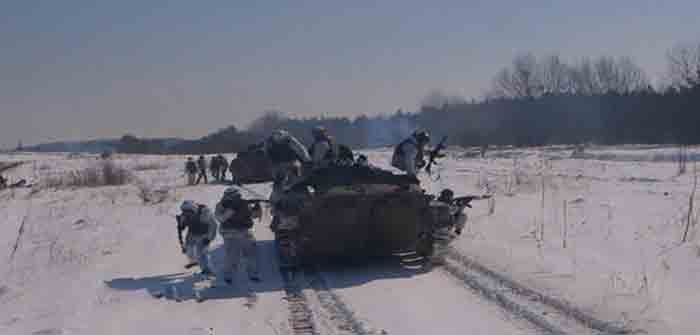
by The Saker at The Saker
Today was only day two of the Russian military operation. And yet, what a day it was!!!
First, a quick update on the progress of Russian forces. Here is a bulletpoint summary for today:
- Kherson: liberated
- Nikolaev: fighting taking pace in outskirts
- Konotop: taken by Russians
- Chernigov: blocked by all sides by Russian forces
- Melitopol: surrounded
- Mariupol: is under attack, street fighting
- Severodonetsk: under attack
- Kharkov: very heavy mopping up operation
- Suma: mopping up operations
- Kiev: blocked from the West and under attack, the authorities are distributing weapons
- Gostomel airport has been captured by Russian forces
- Zaporozhie: Russian forces expected there tomorrow
- A land corridor from Crimea to Russia should be opened by tomorrow.
- Odessa: big question mark – so far, not Russian attacks reported (that I know of!)
Now about Donetsk and Lugansk:
- Both cities are still under fire, and that goes to show that the advance of the LDNR forces has been slow, which is hardly surprising considering that the Ukronazis had 7 years to prepare their defenses. Still, things ARE getting better. Not only that, but the LDNR air defenses shot down a Ukie Tochka-U missile aimed at Donetsk. So it sure looks like the long awaited A2/AA “protective cupola” is being extended over the LDNR.
- That being said, the LDNR forces did break through in at least two directions today, which means that the life left for the Ukie artillery shelling the LDNR will soon come to an end.
But that does not really tell the full story. So I will try to clarify things a little.
A typical battalion has about 400-600 men, depending on the type. Let’s also assume that that battalion has 3-4 companies with APCs, a mortar battery, an air defense platoon, an automatic grenade launcher platoon, a signal platoon, supply platoon, and a few smaller more specialized subunits. If that battalion loses its APCs it has basically lost its most important source of firepower. If its communications are down (destroyed or jammed), then that battalion cannot operate as part of a bigger force and if its supply routes are cut, then its ability to operate (more or fire) will rapidly dwindle down. So, on paper this battalion will remain combat capable, but in reality it will have broken up and cannot be considered a truly combat capable battalion anymore.
So, to destroy/incapacitate a battalion only a few precision strikes are needed. Such strikes though, will leave most of the soldiers alive and quite capable of resistance, but not as a battalion anymore, but more like a typical infantry company or even squads armed with small arms, machine guns, PRG, mines, etc.. They cannot maneuver very much, but they can conduct small hit and run operations against the enemy force. Which means that specialized infantry/police forces must now be send to find these small forces and deal with them in potentially bloody mopping up operations.
Of course, rather than a few precision strikes, it is much more effective to strike the entire battalion with, say, MLRS strikes which will not only destroy most of the hardware, but which will kill most of the soldiers, especially if they did not prepare and seek cover. But that means 400-500 dead in one single strike. That is if this battalion is somewhere in the steppe. But if it is in downtown Mariupol such a strike will inevitably result in even more scores of dead civilians, especially since the Ukies are very careful to always position their artillery near or even on top of buildings.
Does Russia want that?
Not if there is ANY other option left.
Please keep in mind that Russia has the reconnaissance-fire complexes needed obliterate an entire battalion anywhere in the eastern Ukraine in one single salvo. They have deliberately NOT done so today (with one possible exception during the very heavy battle for the Gostomel airport, which was taken by Russian special forces and is now secured as a safe bridgehead for Russian Military-Transport aviation right next to Kiev).
Something similar can be seen in urban offensive operations. It is one thing to get to a city or town’s outskirts, and quite another to penetrate inside the city or town. If the city is lightly defended by small arms fire, that is one thing, but if the city is well defended, in specially engineered defensive circles, with minefield, IEDs, very strong building used as command posts and if the city’s houses and basements have been prepared by combat engineers, then it is much harder to take. Again, one option is to send it dedicated urban combat groups while the other is flatten any building which is used by the defenders as a fortress.
The Russian forces have the means to flatten any building anywhere in the Ukraine, including by cruise missiles, ballistic missiles, MLRS with cluster or fuel-air munition or by using howitzers, heavy mortars and even the TOS-1/TOS-1A heavy flamethrower multi-barrel rocket launch systems.
But, again, that can only be done at a major cost in human lives. Russians won’t hesitate to obliterate some Nazi deathsquads, but to massacre hundreds of regular Ukrainians, irrespective of their personal views, is only and truly a last resort option.
There is a lot of evidence that the Russian forces have moved into the outskirts of many Ukrainian towns, including Kiev, Mariupol and others. Here is how Russian military practice works:…
Continue Reading